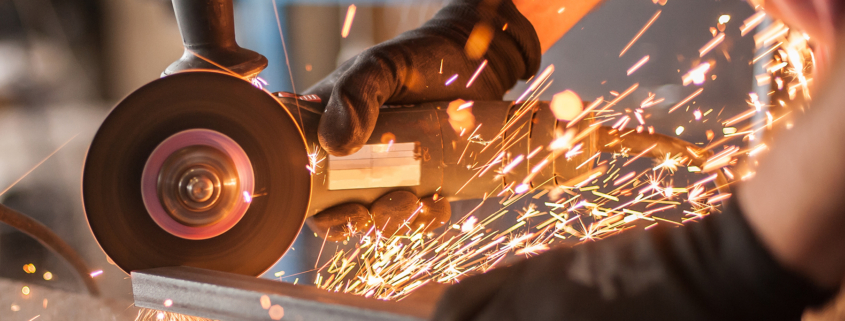Hot Work Operations? Minimize Hazards and Possible Losses
Do your business operations require hot work? There are ways to prevent hazards and potential losses due to fire and even explosion.
Did you know? Among the top three reasons for mid-size industrial and commercial property losses, and one of the leading causes of fire in Canada is operations involving hot work.
We define hot work as any activity that includes work with sources of ignition in the vicinity of flammable materials – welding and soldering, cutting and grinding. When this work happens near flammable gases, liquids or combustible materials such as dust, the risk of fire or explosion is increased.
There are considerable property losses attributable to this kind of activity. But, there are safety protocols and procedures that, when properly followed, can help to significantly reduce dangerous fire hazards and potential subsequent losses.
One little spark… is all it takes
Often, light manufacturing, industrial, and commercial operations dedicate space specifically to activities involving hot work. That’s because it only takes one spark – a small one, in fact – to have a catastrophic impact.
The devastation can include damages to equipment and property, a costly interruption of business operations, and even job losses for your employees. The worst case is lives at risk. An added unfortunate part of this catastrophic picture is, as the business recovers and gets back on its feet, the loss of customers to the competition. The losses are immediate but can also be long-term.
One tiny spark from welding, soldering, grinding or cutting in the wrong conditions can result in untold destruction and devastation.
Minimize the risks of hot work
You may think fire starts immediately. In fact, it’s the opposite – a stray spark can sit in a pile of debris and smoulder over hours before becoming a full-blown fire. In the middle of the night, when there’s no one near to stamp it out.
To manage and minimize the many risks of hot work, there are protocols and best practices you can follow:
- Check that any and all equipment functions properly – before starting work.
- Regularly inspect fire suppression equipment to ensure it’s working properly. Keep it close-at-hand.
- Appropriately clean and store personal protective devices. Have them onsite and readily available. Train staff to use them correctly.
- Inspect the area before starting the work. Inspect for flammable surfaces nearby – the ceilings and walls, any partitions, for instance. Cover them with a heat-insulating or fire-resistant material to minimize heat accumulation and possible ignition.
Work zone – check for combustibles
- Move all combustibles away from the work zone as best you can.
- If flammable items can’t be removed, cover them with fire-resistant blankets or some type of shield. Protect nearby exposed equipment and utility or gas lines from flying or stray hot materials and sparks.
- Tidy any flammable materials from the floors of the work zone. Don’t forget the surrounding area! Are your floors at risk of combusting? Try to cover them with damp sand or fire-resistant blankets. Alternatively, you can keep them wet. Prevent electrical shock – ONLY use water if electrical circuits are de-energized.
- Remove and clean up spilt grease, oil, or other flammable substance.
- To prevent igniting a fire, vacuum flammable or combustible debris from any nearby duct openings inside the ventilation and ductwork. Cracks in ducts? Seal them to ensure that no sparks can get inside.
- Store well-stocked first-aid kits nearby so they’re easy to find.
- For more helpful best practices, CLICK HERE.
A fire watch is essential for safety
With a well-prepared zone for welding, soldering, and other activities, you then need to conduct a fire watch following any hot work.
In the minutes and hours following, assign someone to look for hidden sparks or fire that might smoulder and ignite after hours. You may have to pay a staff member, properly trained in fire suppression and related equipment, to remain on the premises to keep watch. Many businesses that rely on this kind of work understand this is a worthwhile expense to prevent a catastrophe. Choose to forgo the fire watch, you risk potentially devastating consequences.
If you don’t have the budget for a proper fire watch, try your best to limit hot work to the early hours of the day. This gives time to discover any stray sparks or smoulders during the workday. It’s recommended to monitor for approximately one to four hours following any hot work activities.
Permits for hot work
An important component of reducing hot work hazards is a system of hot work permits. It’s a two-part tag system, which requires the operator to complete a safety checklist before they get started with any work beyond the designated hot work zones. One portion of the two-part tag gets affixed near the work area and remains until the completion of your fire watch. The business keeps the other portion of the tag on file, where it stays for auditing by management.
The hot work permit system helps to ensure that those who perform the work follow the required safety protocols. They have to sign off on a checklist before work and again after completion of the fire watch. The permits are available for purchase from many safety supply retailers.
Specific hot work fire safety program
Included in the overall commercial and industrial safety program should include permits for hot work. The policy should include all hot work operations and activities that occur on the premises, whether conducted by staff or third-party contractors.
A hot work section of the safety policy doesn’t need to be complicated – a simple page or two detailing the necessary safety procedures required to perform hot work.
Do you or your business perform hot work? Let us answer any questions you have about your commercial insurance. Talk to us!



